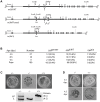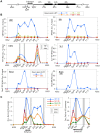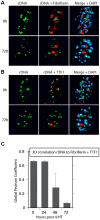Conditional inactivation of Upstream Binding Factor reveals its epigenetic functions and the existence of a somatic nucleolar precursor body
- PMID: 25121932
- PMCID: PMC4133168
- DOI: 10.1371/journal.pgen.1004505
Conditional inactivation of Upstream Binding Factor reveals its epigenetic functions and the existence of a somatic nucleolar precursor body
Abstract
Upstream Binding Factor (UBF) is a unique multi-HMGB-box protein first identified as a co-factor in RNA polymerase I (RPI/PolI) transcription. However, its poor DNA sequence selectivity and its ability to generate nucleosome-like nucleoprotein complexes suggest a more generalized role in chromatin structure. We previously showed that extensive depletion of UBF reduced the number of actively transcribed ribosomal RNA (rRNA) genes, but had little effect on rRNA synthesis rates or cell proliferation, leaving open the question of its requirement for RPI transcription. Using gene deletion in mouse, we now show that UBF is essential for embryo development beyond morula. Conditional deletion in cell cultures reveals that UBF is also essential for transcription of the rRNA genes and that it defines the active chromatin conformation of both gene and enhancer sequences. Loss of UBF prevents formation of the SL1/TIF1B pre-initiation complex and recruitment of the RPI-Rrn3/TIF1A complex. It is also accompanied by recruitment of H3K9me3, canonical histone H1 and HP1α, but not by de novo DNA methylation. Further, genes retain penta-acetyl H4 and H2A.Z, suggesting that even in the absence of UBF the rRNA genes can maintain a potentially active state. In contrast to canonical histone H1, binding of H1.4 is dependent on UBF, strongly suggesting that it plays a positive role in gene activity. Unexpectedly, arrest of rRNA synthesis does not suppress transcription of the 5S, tRNA or snRNA genes, nor expression of the several hundred mRNA genes implicated in ribosome biogenesis. Thus, rRNA gene activity does not coordinate global gene expression for ribosome biogenesis. Loss of UBF also unexpectedly induced the formation in cells of a large sub-nuclear structure resembling the nucleolar precursor body (NPB) of oocytes and early embryos. These somatic NPBs contain rRNA synthesis and processing factors but do not associate with the rRNA gene loci (NORs).
Conflict of interest statement
The authors have declared that no competing interests exist.
Figures









References
-
- Bywater MJ, Pearson RB, McArthur GA, Hannan RD (2013) Dysregulation of the basal RNA polymerase transcription apparatus in cancer. Nat Rev Cancer 13: 299–314. - PubMed
-
- Lessard F, Morin F, Ivanchuk S, Langlois F, Stefanovsky V, et al. (2010) The ARF tumor suppressor controls ribosome biogenesis by regulating the RNA polymerase I transcription factor TTF-I. Mol Cell 38: 539–550. - PubMed
Publication types
MeSH terms
Substances
Associated data
- Actions
Grants and funding
LinkOut - more resources
Full Text Sources
Other Literature Sources
Molecular Biology Databases
Research Materials
Miscellaneous

